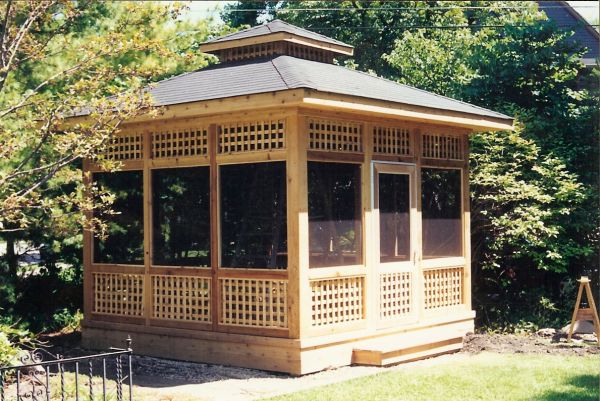Diagrams To Assemble Outdoor Summerhouse : Proper Steps For Building a Perfect Pavilion
They are built over support beams and covered with climbing plants to keep the rooms and outdoor cool. Remember, if you're wanting to build a corner Summer house, checking the base will be done the same way. Dig into the hill to create a flat area for the patio and wall. They would also provide support and attachment points for the intermediate rafters to come later. It's tough to win, but the surest way to hedge your losses is to brief yourself before visiting the lumberyard. Note, if you've decided to buy one of the summer house kits that has arrived as flat pack shed, you could add these to make it more robust.
If it's a budget build, use pressure treated. Moreover measure the diagonals and make sure they are equal. Unroll a strand of hook-and-loop (click this link here) tape across the top of the curtain panel. While still within building code regulations, when combined with a step run of 12 the sum of 19 inches is too much. For this project, beams of size 200x45mm thick will be used. Treated lumber has come a long way in the past few years. The spacious design between the 1st double set of double 2x8's was planned for lighting and running their electric lines. So go ahead -- and press that in.
Plant water plants or grasses along the edge of the pond on the end closest to your home to add some height. You could easily add railings to the gazebo, if you want to build a serving area with an unique design. Position a large layout triangle along a two-by-two at the pergola's front edge. Follow the screw pattern recommended by the manufacturer. Continue this around the perimeter and so on, until all the roof planks are fixed in place. Repeat the process for all the posts, before attaching the rim joists. You will need someone to help you with this task.
The first being that we used left over decomposed granite to fill in the gaps. Simply cut one end of a 2 x 6 at a 45 degree angle, at your desired length, for us that was 4 feet in length. Now take your level and ensure your columns are level. The height of each wall would depend on where you build it. Drill pilot holes and secure the joists to the core block. Once the doorway sections are up, the rest of the panels may be erected. If you don't have a level area, grade the area by removing soil.
Align the eaves at both ends and drive the screws in the top plates. After your support beams are in place, you'll install the girders across them. If you want a little help, find someone to help build your pergola. You would need to factor in how many chairs, how much they weigh, how far they are from the support headers, and which direction they swing, for starters. Warmer temperatures call for outdoor gazebos and that means this summer is the perfect time to add your own. We designed this structure for easy construction. Here are reasons why you should consider having a pavilion in your outdoor space.
In addition, use a jigsaw to make the decorative curved cuts. Not only will you know the quality and care going into it, but you could customize it to suit your gazebo. While the person on the scaffold plank balances the first two opposing rafters, the other could fix the birds-mouth end of the struts to the beam, central over the post. The gable is the most common, and it can be complicated with multiple roof lines, including valleys and dormers. This string line is now at the exact same elevation as the door sill. Finish cutting out the window openings and hearts with a jigsaw.
The gazebo-roof construction could just as easily be used on a patio roof.
